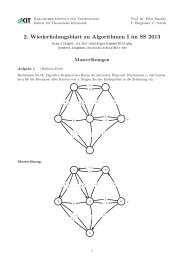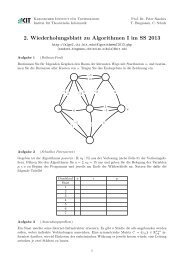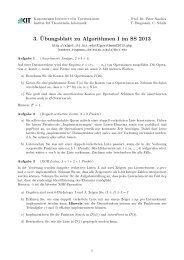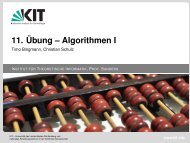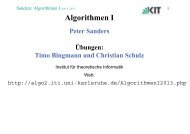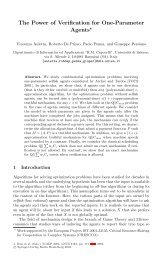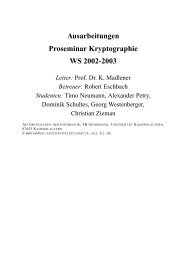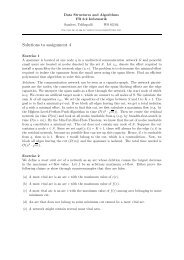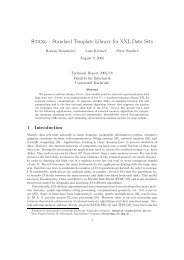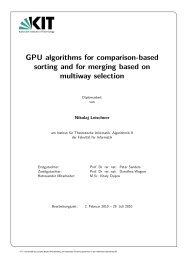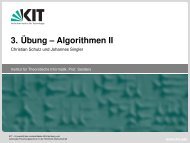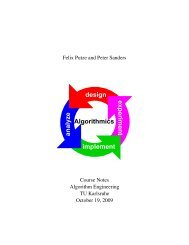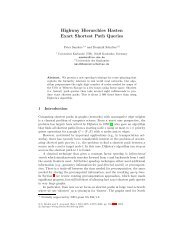Advanced Coarsening Schemes for Graph Partitioning - Ilya ... - KIT
Advanced Coarsening Schemes for Graph Partitioning - Ilya ... - KIT
Advanced Coarsening Schemes for Graph Partitioning - Ilya ... - KIT
You also want an ePaper? Increase the reach of your titles
YUMPU automatically turns print PDFs into web optimized ePapers that Google loves.
1<br />
<strong>Advanced</strong> <strong>Coarsening</strong> <strong>Schemes</strong><br />
<strong>for</strong> <strong>Graph</strong> <strong>Partitioning</strong><br />
<strong>Ilya</strong> Safro, Peter Sanders, Christian Schulz<br />
Argonne National Laboratory and Karlsruhe Institute of Technology (<strong>KIT</strong>)<br />
3<br />
4<br />
LEVEL 0<br />
1 <strong>KIT</strong> <strong>Ilya</strong> – Universität Safro, des Peter LandesSanders, Baden-Württemberg Christian und Schulz:<br />
<strong>Advanced</strong> <strong>Coarsening</strong> <strong>Schemes</strong> <strong>for</strong> <strong>Graph</strong> Partititoning<br />
5<br />
2<br />
6<br />
7<br />
LEVEL 1<br />
Department of In<strong>for</strong>matics<br />
Institute <strong>for</strong> Theoretical Computer Science, Algorithmics II<br />
nationales Groß<strong>for</strong>schungszentrum in der Helmholtz-Gemeinschaft www.kit.edu
Overview<br />
Introduction<br />
Multilevel Algorithms<br />
Algebraic Distance<br />
<strong>Advanced</strong> <strong>Coarsening</strong><br />
Experiments<br />
Summary<br />
2 <strong>Ilya</strong> Safro, Peter Sanders, Christian Schulz:<br />
<strong>Advanced</strong> <strong>Coarsening</strong> <strong>Schemes</strong> <strong>for</strong> <strong>Graph</strong> Partititoning<br />
Department of In<strong>for</strong>matics<br />
Institute <strong>for</strong> Theoretical Computer Science, Algorithmics II
Motivation<br />
Social Networks<br />
SNWs are dense (Facebook > 900M, Google+ > 100M)<br />
too large <strong>for</strong> a single machine<br />
analysis required<br />
3 <strong>Ilya</strong> Safro, Peter Sanders, Christian Schulz:<br />
<strong>Advanced</strong> <strong>Coarsening</strong> <strong>Schemes</strong> <strong>for</strong> <strong>Graph</strong> Partititoning<br />
Department of In<strong>for</strong>matics<br />
Institute <strong>for</strong> Theoretical Computer Science, Algorithmics II
Motivation<br />
Social Networks<br />
distribute graph over multiple machines<br />
analysis: edges between PEs ↔ communication<br />
vertices ↔ computation<br />
3 <strong>Ilya</strong> Safro, Peter Sanders, Christian Schulz:<br />
<strong>Advanced</strong> <strong>Coarsening</strong> <strong>Schemes</strong> <strong>for</strong> <strong>Graph</strong> Partititoning<br />
Department of In<strong>for</strong>matics<br />
Institute <strong>for</strong> Theoretical Computer Science, Algorithmics II
Motivation<br />
Social Networks<br />
<strong>Graph</strong> <strong>Partitioning</strong> Problem:<br />
Partition a graph into (almost) equally sized blocks, such that the<br />
number of edges connecting vertices from different blocks is minimal.<br />
3 <strong>Ilya</strong> Safro, Peter Sanders, Christian Schulz:<br />
<strong>Advanced</strong> <strong>Coarsening</strong> <strong>Schemes</strong> <strong>for</strong> <strong>Graph</strong> Partititoning<br />
Department of In<strong>for</strong>matics<br />
Institute <strong>for</strong> Theoretical Computer Science, Algorithmics II
ɛ-Balanced <strong>Graph</strong> <strong>Partitioning</strong><br />
Partition graph G = (V , E, c : V → R>0, ω : E → R>0)<br />
into k disjoint blocks s.t.<br />
1 + ɛ<br />
total node weight of each block ≤ total node weight<br />
k<br />
total weight of cut edges as small as possible<br />
Applications:<br />
FEM, linear equation systems, VLSI design, route planning, . . .<br />
4 <strong>Ilya</strong> Safro, Peter Sanders, Christian Schulz:<br />
<strong>Advanced</strong> <strong>Coarsening</strong> <strong>Schemes</strong> <strong>for</strong> <strong>Graph</strong> Partititoning<br />
Department of In<strong>for</strong>matics<br />
Institute <strong>for</strong> Theoretical Computer Science, Algorithmics II
Multi-Level <strong>Graph</strong> <strong>Partitioning</strong><br />
Successful in existing systems:<br />
Metis, Scotch, Jostle,. . . , KaPPa, KaSPar, KaFFPa, KaFFPaE<br />
5 <strong>Ilya</strong> Safro, Peter Sanders, Christian Schulz:<br />
<strong>Advanced</strong> <strong>Coarsening</strong> <strong>Schemes</strong> <strong>for</strong> <strong>Graph</strong> Partititoning<br />
Department of In<strong>for</strong>matics<br />
Institute <strong>for</strong> Theoretical Computer Science, Algorithmics II
This Talk<br />
<strong>Advanced</strong> <strong>Coarsening</strong> <strong>Schemes</strong><br />
algebraic multigrid<br />
contract<br />
6 <strong>Ilya</strong> Safro, Peter Sanders, Christian Schulz:<br />
<strong>Advanced</strong> <strong>Coarsening</strong> <strong>Schemes</strong> <strong>for</strong> <strong>Graph</strong> Partititoning<br />
input<br />
graph<br />
...<br />
algebraic distance<br />
Department of In<strong>for</strong>matics<br />
Institute <strong>for</strong> Theoretical Computer Science, Algorithmics II
Algebraic Distance<br />
Relaxation Process<br />
Goal: distinguish local and non-local edges<br />
∀ i ∈ V : x i := rand()<br />
Do k times<br />
∀ i ∈ V : x k<br />
i := (1 − α)x k−1<br />
i<br />
7 <strong>Ilya</strong> Safro, Peter Sanders, Christian Schulz:<br />
<strong>Advanced</strong> <strong>Coarsening</strong> <strong>Schemes</strong> <strong>for</strong> <strong>Graph</strong> Partititoning<br />
+ α ∑j ωijx k−1<br />
j / ∑ij ωij Conjecture<br />
If |x k<br />
i − xk<br />
j | > |xk u − xk v | then the local connectivity between u and v is<br />
stronger than that between i and j.<br />
Department of In<strong>for</strong>matics<br />
Institute <strong>for</strong> Theoretical Computer Science, Algorithmics II<br />
40<br />
20
Algebraic Distance<br />
Example<br />
8 <strong>Ilya</strong> Safro, Peter Sanders, Christian Schulz:<br />
<strong>Advanced</strong> <strong>Coarsening</strong> <strong>Schemes</strong> <strong>for</strong> <strong>Graph</strong> Partititoning<br />
40<br />
goal: distinguish local and non-local edges<br />
20<br />
Department of In<strong>for</strong>matics<br />
Institute <strong>for</strong> Theoretical Computer Science, Algorithmics II
Algebraic Distance<br />
Example - random initialization<br />
assign random values<br />
relaxation steps to equalize<br />
9 <strong>Ilya</strong> Safro, Peter Sanders, Christian Schulz:<br />
<strong>Advanced</strong> <strong>Coarsening</strong> <strong>Schemes</strong> <strong>for</strong> <strong>Graph</strong> Partititoning<br />
Department of In<strong>for</strong>matics<br />
Institute <strong>for</strong> Theoretical Computer Science, Algorithmics II
Algebraic Distance<br />
Example - 10 relaxation steps<br />
relaxation steps to equalize<br />
local differences equalize faster<br />
10 <strong>Ilya</strong> Safro, Peter Sanders, Christian Schulz:<br />
<strong>Advanced</strong> <strong>Coarsening</strong> <strong>Schemes</strong> <strong>for</strong> <strong>Graph</strong> Partititoning<br />
Department of In<strong>for</strong>matics<br />
Institute <strong>for</strong> Theoretical Computer Science, Algorithmics II
Stationary iterative relaxation<br />
rewrite process as x (k+1) = H JORx (k) , where<br />
11 <strong>Ilya</strong> Safro, Peter Sanders, Christian Schulz:<br />
<strong>Advanced</strong> <strong>Coarsening</strong> <strong>Schemes</strong> <strong>for</strong> <strong>Graph</strong> Partititoning<br />
H JOR = (1 − α) I + αD −1 W<br />
⇒ basically the JOR method to solve Lx = 0<br />
L = D − W graph laplacian, α relaxation paramter<br />
algebraic distance ↔ JOR smoothing property<br />
Department of In<strong>for</strong>matics<br />
Institute <strong>for</strong> Theoretical Computer Science, Algorithmics II
Stationary iterative relaxation<br />
rewrite process as x (k+1) = H JORx (k) , where<br />
11 <strong>Ilya</strong> Safro, Peter Sanders, Christian Schulz:<br />
<strong>Advanced</strong> <strong>Coarsening</strong> <strong>Schemes</strong> <strong>for</strong> <strong>Graph</strong> Partititoning<br />
H JOR = (1 − α) I + αD −1 W<br />
⇒ basically the JOR method to solve Lx = 0<br />
L = D − W graph laplacian, α relaxation paramter<br />
H JOR lazy random walk matrix<br />
Department of In<strong>for</strong>matics<br />
Institute <strong>for</strong> Theoretical Computer Science, Algorithmics II
Stationary iterative relaxation<br />
rewrite process as x (k+1) = H JORx (k) , where<br />
11 <strong>Ilya</strong> Safro, Peter Sanders, Christian Schulz:<br />
<strong>Advanced</strong> <strong>Coarsening</strong> <strong>Schemes</strong> <strong>for</strong> <strong>Graph</strong> Partititoning<br />
H JOR = (1 − α) I + αD −1 W<br />
⇒ basically the JOR method to solve Lx = 0<br />
Definition<br />
Extended 2-normed algebraic distance between i and j after k<br />
iterations x (k+1) = Hx (k) on R random initializations<br />
if {i, j} ∈ E, otherwise ρ (k)<br />
ij<br />
ρ (k)<br />
<br />
R<br />
ij := ∑ |x<br />
r=1<br />
(k,r)<br />
i<br />
= 0<br />
− x (k,r)<br />
j | 2<br />
1/2 Department of In<strong>for</strong>matics<br />
Institute <strong>for</strong> Theoretical Computer Science, Algorithmics II
Weighted Aggregation<br />
inspired by AMG<br />
each node may be divided into fractions<br />
different fractions <strong>for</strong>m a coarse node<br />
1. how to select seed nodes<br />
2. how is classical likelihood expressed<br />
3. modification <strong>for</strong> graph partitioning<br />
12 <strong>Ilya</strong> Safro, Peter Sanders, Christian Schulz:<br />
<strong>Advanced</strong> <strong>Coarsening</strong> <strong>Schemes</strong> <strong>for</strong> <strong>Graph</strong> Partititoning<br />
contract<br />
input<br />
graph<br />
...<br />
Department of In<strong>for</strong>matics<br />
Institute <strong>for</strong> Theoretical Computer Science, Algorithmics II
Coarse Nodes<br />
C-points Selection<br />
find dominating set C ⊂ V s.t. F = V \ C “strongly coupled” to C<br />
each node in C is a seed of a coarse aggregate<br />
SEEDS<br />
13 <strong>Ilya</strong> Safro, Peter Sanders, Christian Schulz:<br />
<strong>Advanced</strong> <strong>Coarsening</strong> <strong>Schemes</strong> <strong>for</strong> <strong>Graph</strong> Partititoning<br />
Department of In<strong>for</strong>matics<br />
Institute <strong>for</strong> Theoretical Computer Science, Algorithmics II
Coarse Nodes<br />
C-points Selection<br />
find dominating set C ⊂ V s.t. F = V \ C “strongly coupled” to C<br />
each node in C is a seed of a coarse aggregate<br />
C = ∅, F = V<br />
until<br />
∀u ∈ F : ∑v∈C 1/ρu,v ≥ θ ∑v∈N(u) 1/ρu,v<br />
transfer node from F to C<br />
θ ∈ (0, 1), usually θ = 0.5<br />
14 <strong>Ilya</strong> Safro, Peter Sanders, Christian Schulz:<br />
<strong>Advanced</strong> <strong>Coarsening</strong> <strong>Schemes</strong> <strong>for</strong> <strong>Graph</strong> Partititoning<br />
SEEDS<br />
Department of In<strong>for</strong>matics<br />
Institute <strong>for</strong> Theoretical Computer Science, Algorithmics II
Coarse Nodes<br />
classical AMG interpolation matrix P<br />
express likelihood of v belonging to c ∈ C → P ∈ R |V |x|C|<br />
Pv,c =<br />
⎧<br />
⎪⎨<br />
⎪⎩<br />
15 <strong>Ilya</strong> Safro, Peter Sanders, Christian Schulz:<br />
<strong>Advanced</strong> <strong>Coarsening</strong> <strong>Schemes</strong> <strong>for</strong> <strong>Graph</strong> Partititoning<br />
<br />
Belong to several aggregates<br />
1/ρv,c<br />
∑<br />
k∈N(v)∩C<br />
1/ρ v,k<br />
v ∈ F , c ∈ N(v) ∩ C<br />
1 v ∈ C, v = c<br />
0 otherwise<br />
Department of In<strong>for</strong>matics<br />
Institute <strong>for</strong> Theoretical Computer Science, Algorithmics II
Coarse Nodes<br />
classical AMG interpolation matrix P<br />
express likelihood of v belonging to c ∈ C → P ∈ R |V |x|C|<br />
16 <strong>Ilya</strong> Safro, Peter Sanders, Christian Schulz:<br />
<strong>Advanced</strong> <strong>Coarsening</strong> <strong>Schemes</strong> <strong>for</strong> <strong>Graph</strong> Partititoning<br />
Belong to several aggregates<br />
Lc = P t L f P<br />
volume of c(q ∈ C) := ∑v c(v)Pv,q (sum of weights constant)<br />
wc 1,c 2 = ∑k=l P k,c1 w k,lP l,c2<br />
Department of In<strong>for</strong>matics<br />
Institute <strong>for</strong> Theoretical Computer Science, Algorithmics II
Coarse Nodes<br />
modified AMG interpolation matrix P<br />
express likelihood of v belonging to c ∈ C → P ∈ R |V |x|C|<br />
previous (matching based) work:<br />
17 <strong>Ilya</strong> Safro, Peter Sanders, Christian Schulz:<br />
<strong>Advanced</strong> <strong>Coarsening</strong> <strong>Schemes</strong> <strong>for</strong> <strong>Graph</strong> Partititoning<br />
Belong to several aggregates<br />
vertices should not become too heavy<br />
coarse levels should stay sparse<br />
→ modified algorithm to compute likelihood P<br />
Department of In<strong>for</strong>matics<br />
Institute <strong>for</strong> Theoretical Computer Science, Algorithmics II
Modified Algorithm<br />
Likelihood <strong>for</strong> v ∈ V<br />
restrict to at most two strongest connections → sparsity<br />
avoid overloaded vertices<br />
18 <strong>Ilya</strong> Safro, Peter Sanders, Christian Schulz:<br />
<strong>Advanced</strong> <strong>Coarsening</strong> <strong>Schemes</strong> <strong>for</strong> <strong>Graph</strong> Partititoning<br />
Department of In<strong>for</strong>matics<br />
Institute <strong>for</strong> Theoretical Computer Science, Algorithmics II
Modified Algorithm<br />
Likelihood <strong>for</strong> v ∈ V<br />
if v ∈ C then Pv,v = 1<br />
restrict to at most two strongest connections → sparsity<br />
avoid overloaded vertices<br />
18 <strong>Ilya</strong> Safro, Peter Sanders, Christian Schulz:<br />
<strong>Advanced</strong> <strong>Coarsening</strong> <strong>Schemes</strong> <strong>for</strong> <strong>Graph</strong> Partititoning<br />
Department of In<strong>for</strong>matics<br />
Institute <strong>for</strong> Theoretical Computer Science, Algorithmics II
Modified Algorithm<br />
Likelihood <strong>for</strong> v ∈ V<br />
if v ∈ C then Pv,v = 1<br />
else<br />
find max pair (1/ρe 1 +<br />
1/ρe 2 )<br />
s.t. coarse vertices not<br />
overloaded when<br />
splitting v<br />
restrict to at most two strongest connections → sparsity<br />
avoid overloaded vertices<br />
18 <strong>Ilya</strong> Safro, Peter Sanders, Christian Schulz:<br />
<strong>Advanced</strong> <strong>Coarsening</strong> <strong>Schemes</strong> <strong>for</strong> <strong>Graph</strong> Partititoning<br />
Department of In<strong>for</strong>matics<br />
Institute <strong>for</strong> Theoretical Computer Science, Algorithmics II
Modified Algorithm<br />
Likelihood <strong>for</strong> v ∈ V<br />
if v ∈ C then Pv,v = 1<br />
else<br />
...<br />
if no such pair then<br />
find max edge (1/ρe 1 )<br />
s.t. coarse vertices not<br />
overloaded when<br />
aggregating v<br />
restrict to at most two strongest connections → sparsity<br />
avoid overloaded vertices<br />
18 <strong>Ilya</strong> Safro, Peter Sanders, Christian Schulz:<br />
<strong>Advanced</strong> <strong>Coarsening</strong> <strong>Schemes</strong> <strong>for</strong> <strong>Graph</strong> Partititoning<br />
Department of In<strong>for</strong>matics<br />
Institute <strong>for</strong> Theoretical Computer Science, Algorithmics II
Modified Algorithm<br />
Likelihood <strong>for</strong> v ∈ V<br />
if v ∈ C then Pv,v = 1<br />
else<br />
...<br />
...<br />
if no such edge then<br />
move v to C<br />
restrict to at most two strongest connections → sparsity<br />
avoid overloaded vertices<br />
18 <strong>Ilya</strong> Safro, Peter Sanders, Christian Schulz:<br />
<strong>Advanced</strong> <strong>Coarsening</strong> <strong>Schemes</strong> <strong>for</strong> <strong>Graph</strong> Partititoning<br />
Department of In<strong>for</strong>matics<br />
Institute <strong>for</strong> Theoretical Computer Science, Algorithmics II
Modified Algorithm<br />
Likelihood <strong>for</strong> v ∈ V<br />
N c v ← selected C-nodes<br />
Pv,c ←<br />
1/ρvc<br />
∑ k∈N c v 1/ρ vk , c ∈ N c v<br />
restrict to at most two strongest connections → sparsity<br />
avoid overloaded vertices<br />
18 <strong>Ilya</strong> Safro, Peter Sanders, Christian Schulz:<br />
<strong>Advanced</strong> <strong>Coarsening</strong> <strong>Schemes</strong> <strong>for</strong> <strong>Graph</strong> Partititoning<br />
Department of In<strong>for</strong>matics<br />
Institute <strong>for</strong> Theoretical Computer Science, Algorithmics II
Experiments<br />
Algorithm Configurations<br />
ECO KaFFPaEco, a good trade-off of quality and runtime<br />
ECO-ALG matching based coarsening, refinement as in ECO, rating<br />
function ex alg(e) := expansion ∗2 (e)/ρe<br />
STRONG matching based coarsening, strong refinement scheme<br />
AMG-ECO AMG coarsening based, refinement as in ECO<br />
AMG AMG coarsening based, refinement as in STRONG<br />
expansion ∗2 ({u, v}) := ω({u,v})2<br />
c(u)c(v)<br />
19 <strong>Ilya</strong> Safro, Peter Sanders, Christian Schulz:<br />
<strong>Advanced</strong> <strong>Coarsening</strong> <strong>Schemes</strong> <strong>for</strong> <strong>Graph</strong> Partititoning<br />
Department of In<strong>for</strong>matics<br />
Institute <strong>for</strong> Theoretical Computer Science, Algorithmics II
Experimental Results<br />
Social Networks - Algebraic Distance Helps!<br />
20 <strong>Ilya</strong> Safro, Peter Sanders, Christian Schulz:<br />
<strong>Advanced</strong> <strong>Coarsening</strong> <strong>Schemes</strong> <strong>for</strong> <strong>Graph</strong> Partititoning<br />
ECO<br />
ECO-ALG<br />
ECO<br />
ECO-ALG<br />
k quality full time<br />
2 1.38 0.77<br />
4 1.24 1.32<br />
8 1.15 1.29<br />
16 1.09 1.27<br />
32 1.06 1.18<br />
64 1.06 1.13<br />
Department of In<strong>for</strong>matics<br />
Institute <strong>for</strong> Theoretical Computer Science, Algorithmics II
Experimental Results<br />
Social Networks - AMG helps!<br />
ECO-ALG<br />
AMG-ECO<br />
21 <strong>Ilya</strong> Safro, Peter Sanders, Christian Schulz:<br />
<strong>Advanced</strong> <strong>Coarsening</strong> <strong>Schemes</strong> <strong>for</strong> <strong>Graph</strong> Partititoning<br />
ECO-ALG<br />
AMG-ECO<br />
k quality uncoar. time<br />
2 1.16 3.62<br />
4 1.11 2.14<br />
8 1.07 1.94<br />
16 1.06 1.69<br />
32 1.00 1.60<br />
64 1.01 2.99<br />
Department of In<strong>for</strong>matics<br />
Institute <strong>for</strong> Theoretical Computer Science, Algorithmics II
Experimental Results<br />
Potentially Hard <strong>Graph</strong>s<br />
potentially hard mixtures (star-like structures)<br />
mixtures of snw, fem graphs, VLSI, ...<br />
S 0, . . . , St connected center S 0 by ≤ 3% random edges<br />
ECO<br />
ECO-ALG<br />
22 <strong>Ilya</strong> Safro, Peter Sanders, Christian Schulz:<br />
<strong>Advanced</strong> <strong>Coarsening</strong> <strong>Schemes</strong> <strong>for</strong> <strong>Graph</strong> Partititoning<br />
ECO<br />
ECO-ALG<br />
k quality full time<br />
2 1.42 0.51<br />
4 1.15 0.88<br />
8 1.12 1.08<br />
Department of In<strong>for</strong>matics<br />
Institute <strong>for</strong> Theoretical Computer Science, Algorithmics II
Experimental Results<br />
Potentially Hard <strong>Graph</strong>s<br />
potentially hard mixtures (star-like structures)<br />
mixtures of snw, fem graphs, VLSI, ...<br />
S 0, . . . , St connected center S 0 by ≤ 3% random edges<br />
ECO-ALG<br />
AMG-ECO<br />
ECO-ALG<br />
AMG-ECO<br />
23 <strong>Ilya</strong> Safro, Peter Sanders, Christian Schulz:<br />
<strong>Advanced</strong> <strong>Coarsening</strong> <strong>Schemes</strong> <strong>for</strong> <strong>Graph</strong> Partititoning<br />
STRONG<br />
AMG<br />
STRONG<br />
AMG<br />
k quality uncoar. time quality uncoar. time<br />
2 1.18 0.55 1.15 2.11<br />
4 1.23 0.64 1.13 1.69<br />
8 1.08 0.98 1.05 1.37<br />
Department of In<strong>for</strong>matics<br />
Institute <strong>for</strong> Theoretical Computer Science, Algorithmics II
Conclusion<br />
Experiments<br />
algebraic distance and AMG help on irregular instances<br />
on regular instances (FEM, ...) no significant difference<br />
Further Material in the Paper<br />
more details<br />
more experiments<br />
Future Work<br />
apply AMG and algebraic distance to other multilevel algorithms<br />
implementation within KaFFPa<br />
Lunch<br />
24 <strong>Ilya</strong> Safro, Peter Sanders, Christian Schulz:<br />
<strong>Advanced</strong> <strong>Coarsening</strong> <strong>Schemes</strong> <strong>for</strong> <strong>Graph</strong> Partititoning<br />
Department of In<strong>for</strong>matics<br />
Institute <strong>for</strong> Theoretical Computer Science, Algorithmics II
25 <strong>Ilya</strong> Safro, Peter Sanders, Christian Schulz:<br />
<strong>Advanced</strong> <strong>Coarsening</strong> <strong>Schemes</strong> <strong>for</strong> <strong>Graph</strong> Partititoning<br />
Thank you!<br />
Contact: christian.schulz@kit.edu<br />
sanders@kit.edu<br />
safro@mcs.anl.gov<br />
Department of In<strong>for</strong>matics<br />
Institute <strong>for</strong> Theoretical Computer Science, Algorithmics II



